Business
The Dark Side of Trading Simulators: How They Mislead Novice traders
Trading simulators promise to make you a master trader in no time, but do they deliver on that promise? Well, let’s just say that not everything that glitters is gold.
These virtual trading platforms may seem like a no-risk way to become a pro trader, but the truth is, many of them come with a dark side that can lead novice traders down a path of false confidence and ultimately harm their performance.
In this article, we’re going to explore the sneaky side of trading simulators, and how they can lead novice traders to lose money.
TOP 5 sneaky tactics trading simulators are using to get more users:
1. Giving a huge amount of virtual money
$100 000, $1 000 000 – these are the most common virtual money amounts app developers are giving to the users. When you have a lot of virtual money, you may feel invincible and think that you can’t lose.
This can lead to poor decision-making and overconfidence, which can be a recipe for disaster in the real market. You may also develop bad habits, such as over-trading or failing to properly manage your risks.
In the real world of trading, most people start with a relatively small amount of capital, typically between $100 and $250. That’s why choosing trading simulator with a small amount of virtual capital is a much more realistic and beneficial experience for traders. It will help learn to manage risk and develop good trading habits that will serve well in the real world.
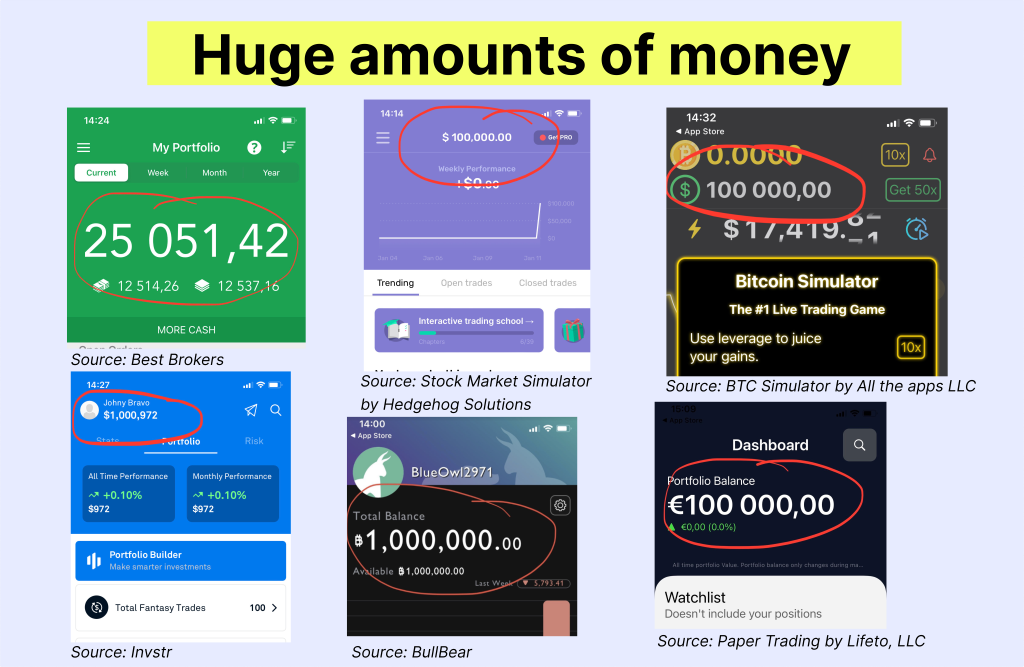
2. Possibility to undo losing trade
Undoing a losing trade doesn’t teach you how to handle losses in the real market.
Let’s face it, in the real world of trading, losses are inevitable. But, by undoing a losing trade in a simulator, you’re not learning how to cope with losses and make better decisions in the future.
It’s like cheating on a test, sure you’ll get a good grade, but you’ll never learn the material.
3. Purchase of more funds
10 undo losing trades for just EUR 9.99, extra $100k game money for just EUR 11.99 – these are just a few options most of the trading simulators offer to buy.
For example, one of the trading simulators offers the possibility to buy a safety net for EUR 1.19, which automatically tops up your cash at the end of the month if your portfolio goes below 1 million. However, this approach can’t teach traders proper risk management. In real life, if you lose, for example, $500, it won’t refresh at the same level even if you pay a symbolic fee.
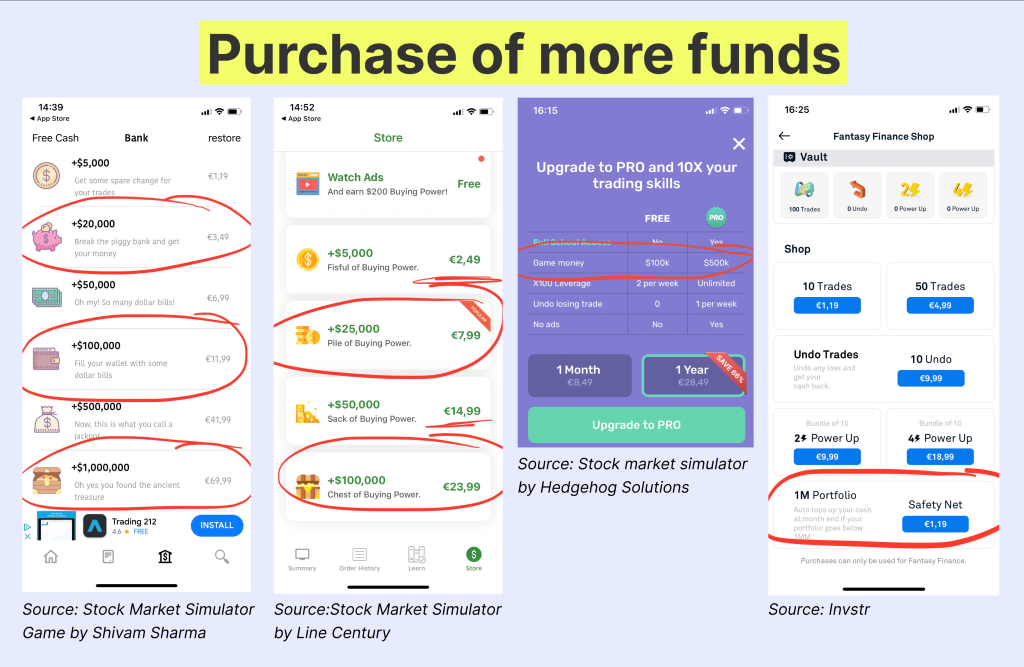
4. Trading with enormous leverage (x100 etc)
Trading with x100 leverage can be like riding a rollercoaster, one minute you’re soaring to new heights, the next you’re plummeting to the depths of despair.
Sure, it’s thrilling to watch your trades with x100 leverage bring in big profits, but one losing trade can wipe out all those gains in a flash.
Using a high leverage can lead to impulsive decisions and overconfidence, as traders may feel like they have more “ammunition” to make bigger trades.
This can make them more likely to over-trade and make emotionally charged decisions, rather than sticking to a well-thought-out trading plan.
Despite the fact that high leverage can be harmful, many trading simulators allow to trade with x100 leverage although under the new ESMA leverage regulations, the highest allowed leverage is x30 (for major currency pairs).
Below you can see one of the Reddit users who shared his experience of trading with x1, x10 and x100 leverage and how scary high leverage losses can be. 👇
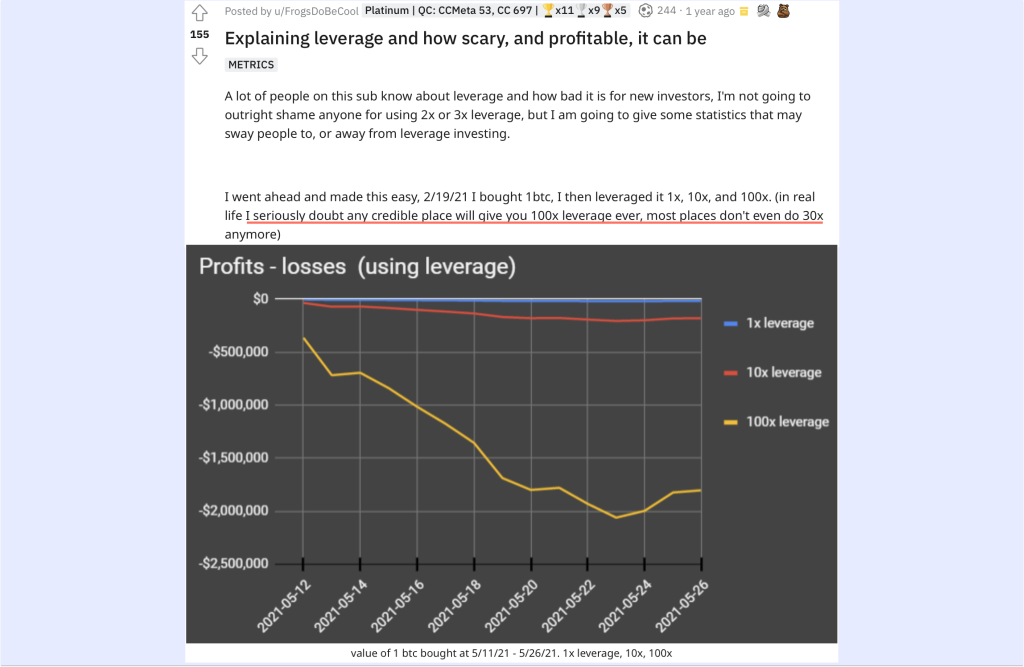
5. No stop-loss and take-profit function
Some of the trading simulators don’t offer the stop loss function. The stop loss and take profit options are important risk management tools that can help traders limit their losses and lock in profits.
Not having these options in a trading simulator can make it less effective in preparing traders for real trading.
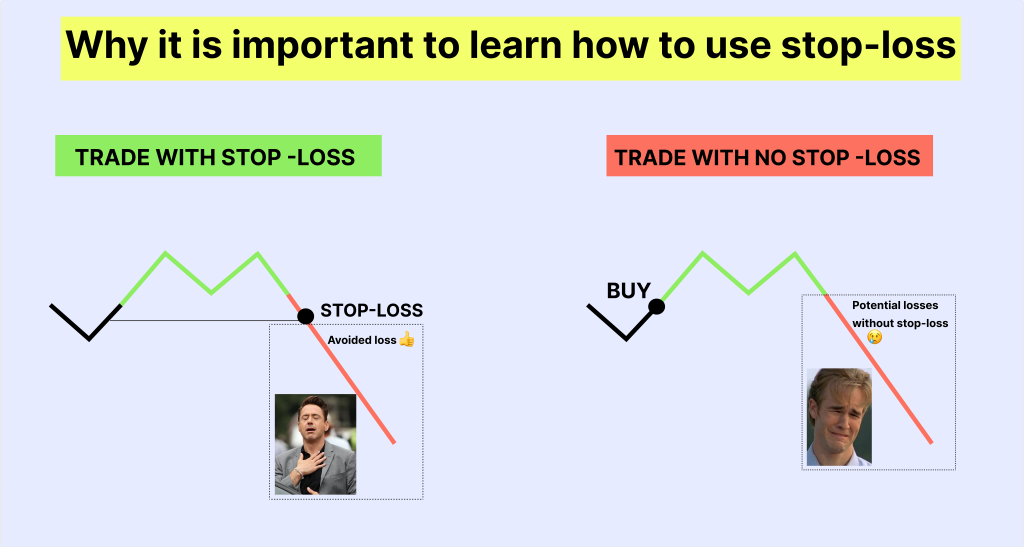
Let’s be honest, trading simulators offering in-app purchases like the ability to undo losing trades or reset your account to a whopping $1,000,000 are all about one thing: making profit to app developers!
These features may seem like a dream come true, but they’re not something you’ll find in the real trading world. In the real trading world, when you lose, you lose, and there’s no magic undo button to save the trade.
Of course, someone could say, ‘Yes, but they are just using gamification tools to engage users.’
However, the real story is that many of them are affiliated with brokers, so their main goal is to get the user to sign up for the broker as quickly as possible.
This is achieved by giving the trader the false impression that they can make a lot of money with trading and that they have learned all the main things to be a profitable trader in the real life.
💡 In 2018, the ESMA implemented the MiFID II directive, which requires all online derivatives trading brokers operating in the European Union to publicly disclose the percentage of their
clients who lose money. On average, 72% of traders who trade within the ESMA jurisdiction experience losses.
And one of the reasons it might happen is because of these trading simulators which give new traders the confidence that they are willing to risk their money much sooner than they actually should.
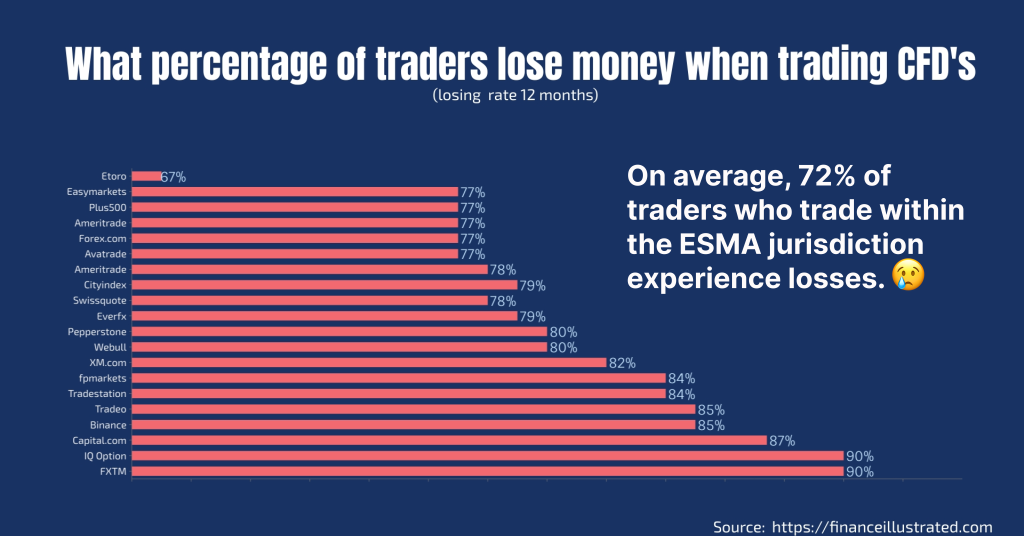
List with the trading simulators which are using sneaky tactics:
1. BullBear simulator – $1 000 000 virtual capital, no stop-loss/take profit orders.
2. Investmate – no stop-loss/take profit orders, static prices.
3. Best brokers trading simulator – giving $25 000 virtual starting capital.
4. Three Investeers – 100 000 virtual capital. When choosing PRO plan, possibility to undo losing trade, x100 leverage, $500k virtual capital.
5. Invstr – Starting cash $ 1 000 000. Fantasy finance shop, where users can buy possibility to undo losing traders and auto top up your cash at month end if your portfolio goes belowe 1MM. No stop-loss/take profit orders and candlestick charts in a free version.
6. Stock market Simulator by Line century – in-app store where you can purchase $100 000 buying power for EUR 23,99.
7. BTC Simulator by All the Apps LLC – $1000 000 virtual starting capita, possibility to spin the fortune wheel and get up to $100k extra and x100 leverage.
8. Paper trading by Lifeto – $100 000 virtual starting capital, no stop-loss.
TOP 3 trading simulators with ethical educational approach
#1 The Trading Game – Best for Novice Traders
The Trading Game is all on one trading simulator and school that aims to educate users on Forex, Stocks, Commodities, Indices and Crypto and provide tools to help novice traders improve their trading skills.
When you first enter the game, you have the option to choose the amount of money you want to start with. This game is all about making sure you learn how not to lose money.
Risk management tools, a learning section looking at different strategies to see which might work best for you, expert advice, performance tracker, and most important – it’s totally free. Trusted by 2,405,000+ students worldwide
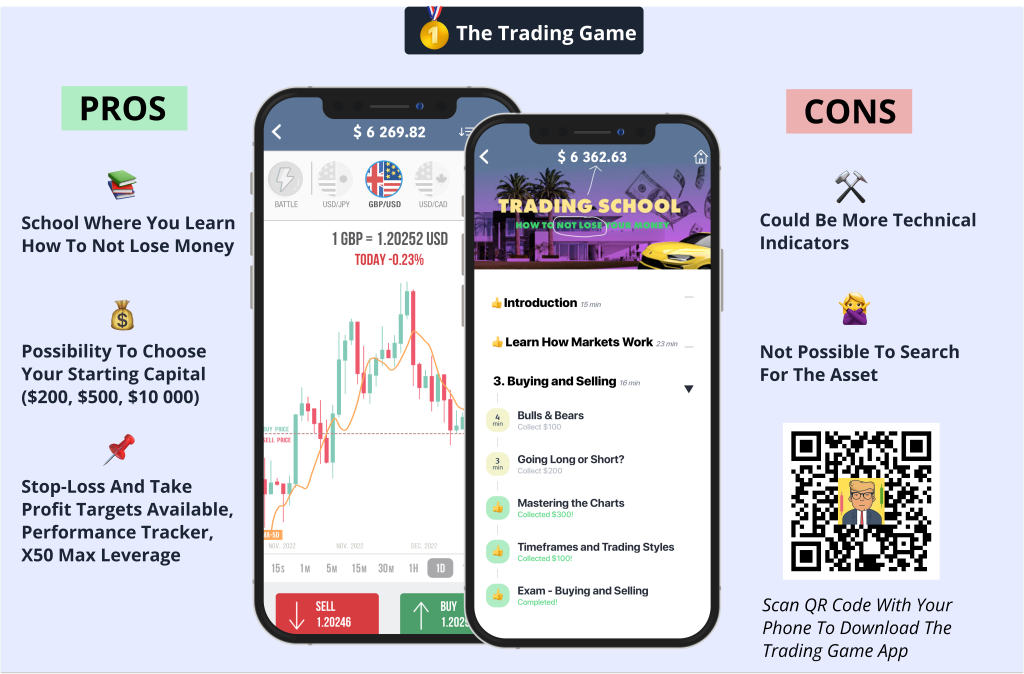
#2 Investopedia – For trading insights
With more than 3 million users across the world, Investopedia definetely is a Top G in the financial learning sector.
The site offers a dictionary of financial terms and a variety of educational articles, guides, and videos on topics such as stock market investing, retirement planning, and financial analysis.
Investopedia also provides a simulated trading platform, allowing users to practice their investment strategies in a risk-free environment.
In addition, Investopedia also provides news, analysis, and market data on a wide range of financial instruments and markets.
Even if the website is a bit outdated and needs improvements this is a good place where traders can learn about trading for free.
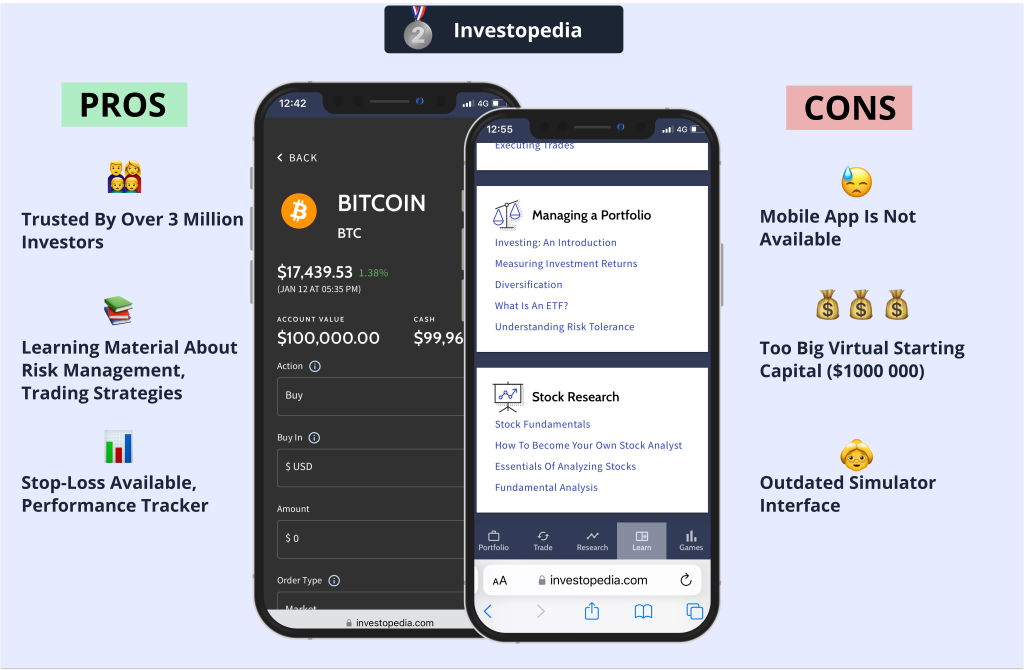
#3 TradingView – Best for PRO traders
TradingView is a financial charting and analysis platform that allows users to view and analyze stocks, forex, cryptocurrency, and other financial markets.
It features a variety of technical indicators, charting tools, and customizable alerts to help traders make informed decisions.
Additionally, TradingView offers a community aspect, where users can share and view ideas, strategies, and market insights with other traders. For beginners, this platform might be too complicated, but if you are a PRO trader, it is definitely worth a try.
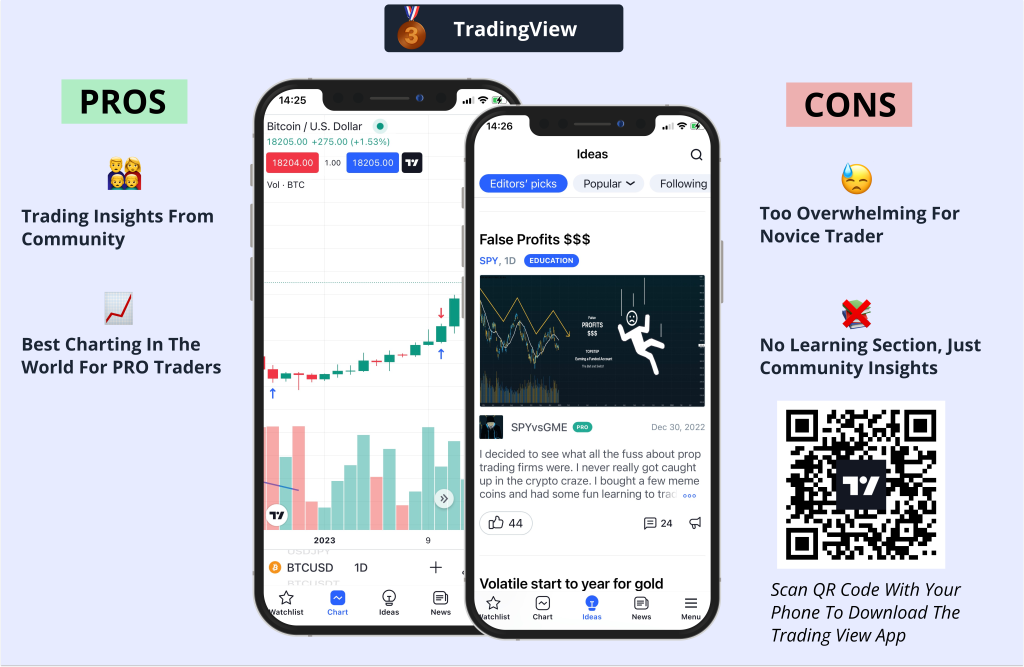
Related CTN News:
State-Run Banks Announce Higher Interest Rates For Loans
Japan Firm Installs Whale Meat Vending Machines To Boost Sales
FTX Founder Bankman-Fried Opposes Tighter Bail, Accusing Prosecutors Of ‘bullying’ Him

Business
PepsiCo Reduces Revenue Projections As North American Snacks And Key International Markets Underperform.

(VOR News) – In the third quarter of this year, Pepsi’s net income was $2.93 billion, which is equivalent to $2.13 per share. This was attributed to the company.
This is in stark contrast to net income of $3.09 billion, which is equivalent to $2.24 per share, during the same period in the previous year. The company’s earnings per share were $2.31 when expenses were excluded.
Net sales decreased by 0.6%, totaling $23.32 billion. Organic sales increased by 1.3% during the quarter when the effects of acquisitions, divestitures, and currency changes are excluded.
Pepsi’s beverage sales fell this quarter.
The most recent report indicates that the beverage and food sectors of the organization experienced a 2% decline in volume. Consumers of all income levels are demonstrating a change in their purchasing habits, as indicated by CEOs’ statements from the previous quarter.
Pepsi’s entire volume was adversely affected by the lackluster demand they encountered in North America. An increasing number of Americans are becoming more frugal, reducing the number of snacks they ingest, and reducing the number of times they purchase at convenience stores.
Furthermore, Laguarta observed that the increase in sales was partially attributed to the election that occurred in Mexico during the month of June.
The most significant decrease in volume was experienced by Quaker Foods North America, which was 13%. In December, the company announced its initial recall in response to a potential salmonella infection.
Due to the probability of an illness, the recall was extended in January. Pepsi officially closed a plant that was implicated in the recalls in June, despite the fact that manufacturing had already been halted.
Jamie Caulfield, the Chief Financial Officer of Pepsi and Laguarta, has indicated that the recalls are beginning to have a lessening effect.
Frito-Lay experienced a 1.5% decline in volume in North America. The company has been striving to improve the value it offers to consumers and the accessibility of its snack line, which includes SunChips, Cheetos, and Stacy’s pita chips, in the retail establishments where it is sold.
Despite the fact that the category as a whole has slowed down in comparison to the results of previous years, the level of activity within the division is progressively increasing.
Pepsi executives issued a statement in which they stated that “Salty and savory snacks have underperformed year-to-date after outperforming packaged food categories in previous years.”
Pepsi will spend more on Doritos and Tostitos in the fall and winter before football season.
The company is currently promoting incentive packets for Tostitos and Ruffles, which contain twenty percent more chips than the standard package.
Pepsi is expanding its product line in order to more effectively target individuals who are health-conscious. The business announced its intention to acquire Siete Foods for a total of $1.2 billion approximately one week ago. The restaurant serves Mexican-American cuisine, which is typically modified to meet the dietary needs of a diverse clientele.
The beverage segment of Pepsi in North America experienced a three percent decrease in volume. Despite the fact that the demand for energy drinks, such as Pepsi’s Rockstar, has decreased as a result of consumers visiting convenience stores, the sales of well-known brands such as Gatorade and Pepsi have seen an increase throughout the quarter.
Laguarta expressed his opinion to the analysts during the company’s conference call, asserting, “I am of the opinion that it is a component of the economic cycle that we are currently experiencing, and that it will reverse itself in the future, once consumers feel better.”
Additionally, it has been noted that the food and beverage markets of South Asia, the Middle East, Latin America, and Africa have experienced a decline in sales volume. The company cut its forecast for organic revenue for the entire year on Tuesday due to the business’s second consecutive quarter of lower-than-anticipated sales.
The company’s performance during the quarter was adversely affected by the Quaker Foods North America recalls, the decrease in demand in the United States, and the interruptions that occurred in specific international markets, as per the statements made by Chief Executive Officer Ramon Laguarta.
Pepsi has revised its forecast for organic sales in 2024, shifting from a 4% growth rate to a low single-digit growth rate. The company reiterated its expectation that the core constant currency profitability per share will increase by a minimum of 8% in comparison to the previous year.
The company’s shares declined by less than one percent during premarket trading. The following discrepancies between the company’s report and the projections of Wall Street were identified by LSEG in a survey of analysts:
SOURCE: CNBC
SEE ALSO:
Old National Bank And Infosys Broaden Their Strategic Partnership.
Business
Old National Bank And Infosys Broaden Their Strategic Partnership.
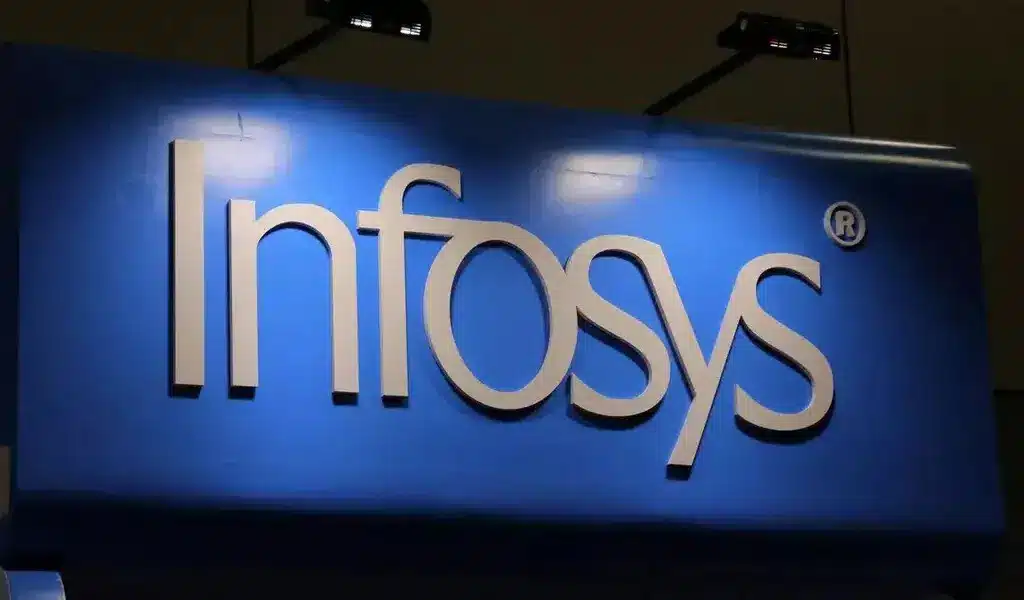
(VOR News) – Old National Bank, a commercial bank with its headquarters in the Midwest, and Infosys, a firm that specializes in information technology, have recently entered into a strategic expansion of their link, which has been in place for the past four years.
This expansion is more likely to take place sooner rather than later, with the likelihood being higher.
For the purpose of making it possible for Old National Bank to make use of the services, solutions, and platforms that are offered by Infosys, the objective of this expansion is to make it possible for the bank to transform its operations and processes through the application of automation and GenAI, as well as to change significant business areas.
This lets the bank leverage Infosys’ services, solutions, and platforms.
Old National Bank Chairman and CEO Jim Ryan said, “At Old National, we are committed to creating exceptional experiences for both our customers and our fellow employees.”
This statement is applicable to Old National Bank. Infosys is carefully managing the business process innovations that it is putting us through, putting a strong emphasis on efficiency and value growth throughout the process to ensure that it is carried out efficiently.
This is a routine occurrence throughout the entire operation. Because of Infosys’ dedication to our development and success, we are incredibly appreciative of the assistance they have provided.
Old National has been receiving assistance from Infosys in the process of updating its digital environment since the year 2020, according to the aforementioned company.
Ever since that time, the company has been providing assistance. The provision of this assistance has been accomplished through the utilization of a model that is not only powerful but also capable of functioning on its own power.
Infosys currently ranks Old National thirty-first out of the top thirty US banks.
This ranking is based on the fact that Old National is the nation’s largest banking corporation.
It is estimated that the total value of the company’s assets is approximately fifty-three billion dollars, while the assets that are currently being managed by the organization are valued at thirty billion dollars.
Dennis Gada, the Executive Vice President and Global Head of Banking and Financial Services, stated that “Old National Bank and Infosys possess a robust cultural and strategic alignment in the development, management, and enhancement of enterprise-scale solutions to transform the bank’s operations and facilitate growth.”
This remark referenced the exceptional cultural and strategic synergy between the two organizations. Dennis Gada is the one who asserted this claim. This was articulated explicitly concerning the exceptional cultural congruence and strategy alignment of the two organizations.
We are pleased to announce that the implementation of Infosys Topaz will substantially expedite the transformation of Old National Bank’s business processes and customer service protocols. We are exceedingly enthusiastic about this matter. We are quite thrilled about this specific component of the scenario.
Medium-sized banks operating regionally will continue to benefit from our substantial expertise in the sector, technology, and operations. This specific market segment of Infosys will persist in benefiting from our extensive experience. This phenomenon will enable this market sector to sustain substantial growth and efficiency benefits.
SOURCE: THBL
SEE ALSO:
American Water, The Largest Water Utility In US, Is Targeted By A Cyberattack
States Sue TikTok, Claiming Its Platform Is Addictive And Harms The Mental Health Of Children
Qantas Airways Apologizes After R-Rated Film Reportedly Airs On Every Screen During Flight
Business
American Water, The Largest Water Utility In US, Is Targeted By A Cyberattack

The largest regulated water and wastewater utility company in the United States stated Monday that it had been the target of a cyberattack, forcing the company to halt invoicing to consumers.
American Water, The Largest Water Utility In US, Is Targeted By A Cyberattack
American Water, based in New Jersey and serving over 14 million people in 14 states and 18 military facilities, said it learned of the unauthorized activity on Thursday and quickly took precautions, including shutting down certain systems. The business does not believe the attack had an impact on its facilities or operations and said employees were working “around the clock” to determine the origin and scale of the attack.

According to their website, American Water operates over 500 water and wastewater systems in around 1,700 communities across California, Georgia, Hawaii, Illinois, Indiana, Iowa, Kentucky, Maryland, Missouri, New Jersey, Pennsylvania, Tennessee, Virginia, and West Virginia.
SOURCE | AP
-

 News3 years ago
News3 years agoLet’s Know About Ultra High Net Worth Individual
-
Entertainment2 years ago
Mabelle Prior: The Voice of Hope, Resilience, and Diversity Inspiring Generations
-

 Health4 years ago
Health4 years agoHow Much Ivermectin Should You Take?
-

 Tech2 years ago
Tech2 years agoTop Forex Brokers of 2023: Reviews and Analysis for Successful Trading
-

 Lifestyles3 years ago
Lifestyles3 years agoAries Soulmate Signs
-

 Movies2 years ago
Movies2 years agoWhat Should I Do If Disney Plus Keeps Logging Me Out of TV?
-

 Health3 years ago
Health3 years agoCan I Buy Ivermectin Without A Prescription in the USA?
-

 Learning3 years ago
Learning3 years agoVirtual Numbers: What Are They For?